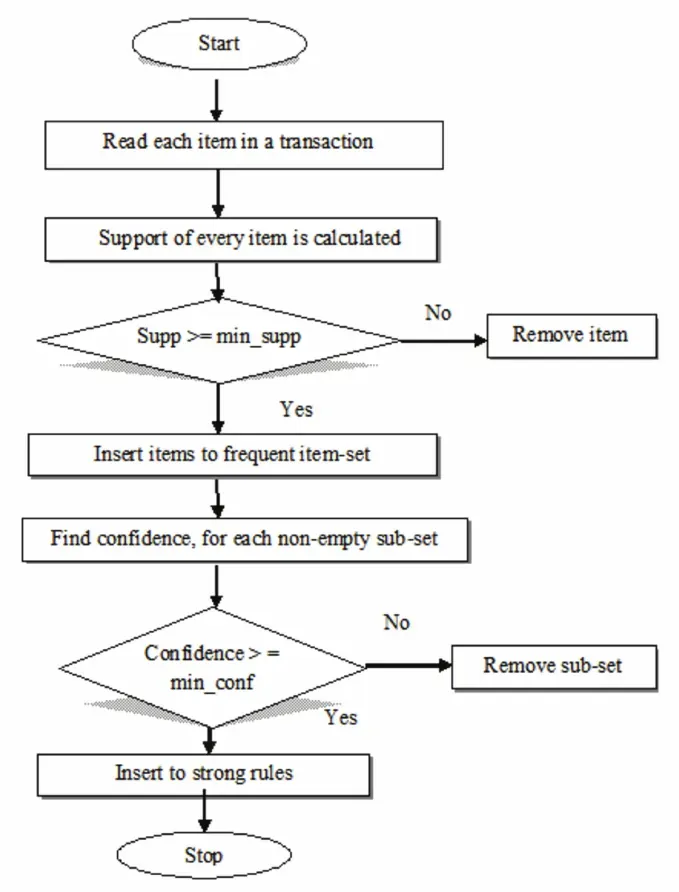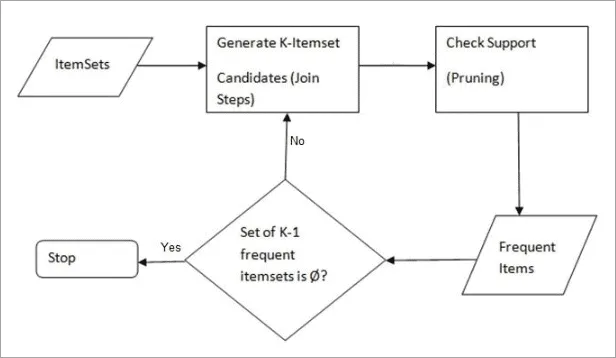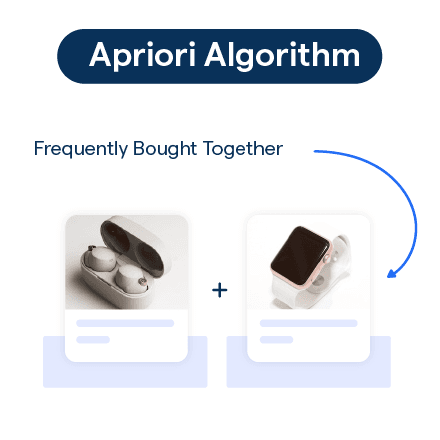What is the Apriori Algorithm?
The Apriori Algorithm is a popular algorithm used in data mining and machine learning to discover frequent itemsets and association rules between items.
It was proposed by R. Agrawal in 1994, and it's widely used in market basket analysis, where it's used to identify items that are bought together frequently, which can be used to optimize product placement and increase sales.

Overview of the Algorithm
The Apriori Algorithm is a rule-based approach that uses frequent itemsets to generate strong association rules between items.
The algorithm works on the principle of finding the most frequent itemsets in a given dataset, and then using these itemsets to generate association rules.
These association rules can be used to discover hidden patterns and relationships between different items in the dataset.
Importance and Applications of the Algorithm
The Apriori Algorithm is widely used in various industries, including retail, finance, healthcare, and many more.
In retail, the algorithm is used to optimize product placement and increase sales by identifying frequently bought items that can be placed together.
In healthcare, it's used to analyze medical records and identify frequent disease patterns, which can be used to improve patient care.
The algorithm is also used in finance to detect fraudulent transactions by identifying unusual patterns in transaction data.
Different Use- Cases of BotPenguin:
Basics of the Apriori Algorithm
Now that we've covered the basics of the Apriori Algorithm, it's time to delve deeper into how it works.
How Does the Apriori Algorithm Work?
The Apriori Algorithm works by iteratively creating candidate itemsets of size k, where k is the size of the frequent itemsets found in the previous iteration.
These candidate itemsets are generated by joining the frequent itemsets using a join operation.
The candidate itemsets are then pruned based on their support, and the frequent itemsets are selected for the next iteration. This process is repeated until no more frequent itemsets can be generated.
Core Concepts and Principles Behind the Algorithm
To understand the Apriori Algorithm, it's important to understand the core concepts and principles behind it.
The algorithm works on the notion of frequent itemsets, which are sets of items that occur together frequently in a given dataset. The algorithm identifies these frequent itemsets and uses them to generate association rules.
These association rules can be used to discover hidden patterns and relationships between different items in the dataset.
Understanding Frequent Itemsets and Association Rules
Frequent itemsets are sets of items that occur together frequently in a given dataset.
These itemsets can be of any size, and the Apriori Algorithm is used to identify these frequent itemsets. Once these frequent itemsets are identified, association rules can be generated from them.
Association rules are a set of rules that indicate the relationship between different items in a dataset. These association rules can be used to discover hidden patterns and relationships between different items in the dataset.
How to Apply the Apriori Algorithm?
In this section, we will cover the step-by-step process of applying the Apriori Algorithm to find insights.
Step 1
Data Preparation
Before applying the Apriori algorithm, you need to prepare your data. This typically involves cleaning the data, handling missing values, and converting transactions into a binary format where each row denotes a unique transaction and each column represents an item.
Step 2
Define Minimum Support and Confidence

The first key step while running the Apriori Algorithm is setting the minimum Support and Confidence.
Support measures the frequency of an item set in all transactions, while Confidence indicates the likelihood of an item B being purchased when item A is purchased.
Step 3
Generate Candidate Itemsets
The next step is to generate candidate itemsets. Initially, the frequency of each item in the dataset is calculated and those meeting the minimum support threshold are selected. These form the first set of frequent itemsets, often denoted as L1.

Step 4
Form Larger Itemsets
Next, these frequent itemsets are used to generate larger itemsets. For example, two frequent itemsets from L1 (like {A} and {B}) are combined to produce L2 ({A, B}).
Again, the support is calculated for these larger itemsets and only those meeting the minimum support threshold are kept.
Step 5
Repeat Until No More Frequent Itemsets
This process is repeated, forming larger and larger itemsets each time, until no more frequent itemsets can be formed which meet the minimum support. Finally, the Apriori algorithm identifies rules from these itemsets based on the defined minimum confidence.
Applying the Apriori Algorithm can help uncover significant associations and trends within your data, which in turn can fuel insightful business solutions and strategies.
Advantages and Disadvantages of the Apriori Algorithm
In this section, we'll discuss the advantages and disadvantages of the Apriori Algorithm, offering valuable insight into its effectiveness and limitations in mining frequent itemsets.
Advantages of Apriori Algorithm
Let us first begin with the advantages of apriori algorithm.
Simplicity and Ease of Implementation
The Apriori Algorithm is quite straightforward and relatively easy to implement. Its simplicity lies in generating candidate itemsets and using support and confidence thresholds to determine associations.
Efficient Pruning
The Apriori principle allows the algorithm to efficiently prune unlikely itemsets early on in the process, reducing the number of calculations required and speeding up the overall computation.
Scalability
The Apriori Algorithm is highly scalable and can handle large-scale datasets effectively, making it suitable for various applications and industries.
Disadvantages of Apriori Algorithm
As every coin has another side, so does the apriori algorithm. Now let us have a look at its disadvantages.
Computational Complexity
Despite the pruning technique, the Apriori Algorithm can still be computationally complex, especially when dealing with numerous items and large datasets, potentially hindering its performance.
Multiple Scans of the Dataset
The Apriori Algorithm requires multiple scans of the dataset to calculate support and generate itemsets, which may result in slower processing times for very large datasets.
Improving the Efficiency of the Apriori Algorithm
In this section, we'll explore various strategies for improving the efficiency of the Apriori Algorithm, making it more suitable for large-scale data mining tasks.
Use Efficient Data Structures
Choosing the right data structures for itemset storage and support count can greatly enhance the performance.
Utilizing hash trees or trie data structures can aid in faster itemset lookup and update operations.
Parallelize the Algorithm
Running the Apriori Algorithm on a distributed system or leveraging multi-core processors can result in faster performance by processing multiple itemsets in parallel.
Optimize Support Count Calculation
Reducing the number of dataset scans can significantly improve the efficiency of the algorithm.
Consider developing methods to calculate support counts while minimizing the total scans, or use preprocessed data to eliminate the need for re-scanning the dataset.
Adopt Variations of Apriori Algorithm
There are several modified versions of the Apriori Algorithm, such as the Eclat Algorithm or FP-Growth Algorithm, that focus on improving efficiency.
Using one of these variations can lead to better performance depending on your dataset and requirements.
Reduce the Dataset Dimensionality
Before applying the Apriori Algorithm, use dimensionality reduction techniques like Principal Component Analysis (PCA) or Singular Value Decomposition (SVD) to process the data and remove any redundant features, making the algorithm more efficient.
By incorporating these strategies, you can effectively boost the efficiency of the Apriori Algorithm, making it a more powerful tool for uncovering valuable patterns and insights in your data
In this section, we'll walk through the core components of the Apriori Algorithm, popular in data mining for identifying association rules, along with pertinent formulas.
Components of the Apriori Algorithm

At the Apriori algorithm's heart lies the key principle: any subset of a frequent itemset must be frequent.
This principle helps in cutting down computations by removing infrequent candidates.
Recognizing Support and Confidence
Support and Confidence are the critical metrics guiding the Apriori algorithm. Formally, the formulas for these metrics are:
Support(X) = (Transactions containing (X))/(Total Transactions)
Confidence(X→Y) = (Transactions containing both (X and Y))/(Transactions containing X)
Support measures itemsets' frequency in transactions, while confidence gauges the probability of item Y being purchased when item X is purchased.
Generation of Candidate Itemsets
Candidate itemsets are derived from the larger frequent itemsets from the previous step, taking into account the minimum support threshold.
Pruning of Infrequent Itemsets
The algorithm prunes non promising candidates during the generation of candidate itemsets. Infrequent itemsets and their supersets are eliminated from the pool, reducing computation.
Mining of Association Rules
Finally, the algorithm employs the support/confidence framework to mine out the association rules from those itemsets passing the minimum support and confidence thresholds, thereby deriving valuable patterns in the dataset.
Applications of the Apriori Algorithm
The Apriori Algorithm has a wide range of applications in various industries, including retail, finance, healthcare, and many more.
In this section, we'll cover the vast and varied applications of the Apriori algorithm, a popular method used in data mining for discovering frequent itemsets.
E-commerce and Retail

E-commerce and brick-and-mortar retail stores use the Apriori algorithm to analyze customer purchase patterns.
This helps in product bundling, for instance, understanding that if a customer buys cereal, they are likely to buy milk too.
Media Streaming Platforms

Streaming platforms like Netflix, Spotify or YouTube leverage the Apriori algorithm to recommend content based on what a user or similar users have frequently watched or listened to, enhancing user experience via personalized content curation.
Medical Diagnostics
In healthcare, the Apriori algorithm can be used for diagnosing diseases by identifying sets of symptoms that often occur together.
It aids doctors and healthcare professionals in understanding disease patterns and enabling effective diagnosis and treatment.
Web Usage Mining
The Apriori algorithm is used for web usage mining, where it helps uncover patterns in the way users navigate through websites.
This information can be used to restructure website design or recommend relevant content, thereby improving the user experience.
Network Traffic Analysis
In the realm of cybersecurity, the Apriori algorithm is used for network traffic analysis. It helps to identify frequent patterns of normal traffic and hence detect any unusual network behavior or potential cyber threats.
Across industries—from retail to healthcare, and from media to cybersecurity—the Apriori algorithm has found critical applications helping developers and data scientists to uncover intriguing patterns and provide insightful solutions.
Frequently Asked Questions (FAQs)
What is the Apriori Algorithm?
The Apriori algorithm is a data mining technique for frequent item set mining and association rule learning.
It searches for frequent item sets by identifying subsets common to at least a minimum number of the item sets.
What are the main steps of the Apriori Algorithm?
The Apriori algorithm has two main steps:
The first step counts the frequency of each item in the dataset.
The second step uses the results of the first step to generate candidate itemsets of size two, then three, and so on, until no more frequent itemsets can be found.
What is meant by Support, Confidence, and Lift in the context of the Apriori Algorithm?
Support is the frequency of occurrence of an itemset. Confidence is the likelihood of the itemset appearing given that another item has already appeared.
Lift is the ratio of the actual frequency of the itemset to the expected frequency.
What is the minimum support in the Apriori Algorithm?
The minimum support is the threshold below which itemsets are ignored. Itemsets with frequencies at or above the minimum support are considered frequent itemsets.
What are the types of association rules that can be learned from the Apriori Algorithm?
Association rules can be classified into strong, weak, positive, and negative association rules depending on the values of support, confidence, and lift.
Strong association rules have high values for all three metrics, while negative association rules have a lift value of less than 1.

